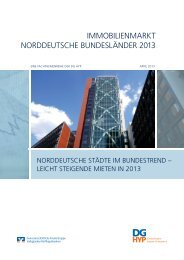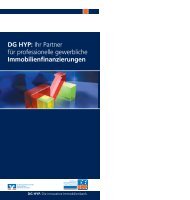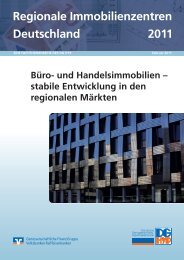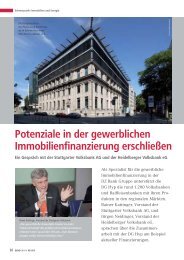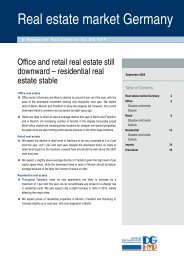ANNUAL REPORT 2006 - DG Hyp
ANNUAL REPORT 2006 - DG Hyp
ANNUAL REPORT 2006 - DG Hyp
You also want an ePaper? Increase the reach of your titles
YUMPU automatically turns print PDFs into web optimized ePapers that Google loves.
RESIDENTIAL REAL ESTATE FINANCE IN GERMANY:<br />
New opportunities in a changing market<br />
The German residential real estate market has undergone<br />
fundamental change in recent years. Whilst a variety<br />
of factors have been driving the trend towards a classic<br />
buyer’s market, with increasingly predatory competition,<br />
the residential real estate finance business continues to<br />
offer outstanding opportunities for building and maintaining<br />
long-term customer relationships – with associated<br />
cross-selling potential. In this environment, all market<br />
participants are facing new, extraordinary challenges – yet<br />
at the same time, they are finding new opportunities by<br />
developing attractive products responding to the needs of<br />
the market, and of target groups.<br />
Germany: one of Europe’s most attractive real estate<br />
markets<br />
Germany ranks amongst the most attractive European<br />
real estate markets, not just due to the sheer size of its<br />
82-million population and its position at the very heart of<br />
Europe, but also given the very low proportion of citizens<br />
owning the properties they live in. At just 43 per cent, this<br />
indicates significant potential to catch up with other<br />
international markets. However, the overall volume of new<br />
residential construction has been stagnating for years.<br />
RESIDENTIAL REAL ESTATE MARKET –<br />
NEW CONSTRUCTION/MODERNISATION/PURCHASES (1996–<strong>2006</strong>)<br />
€ bn<br />
150<br />
100<br />
50<br />
4 Deutsche Genossenschafts-<strong>Hyp</strong>othekenbank AG | Annual Report <strong>2006</strong><br />
Whilst new construction activity has declined significantly<br />
since the beginning of this decade – currently unchanged<br />
at around € 53 billion – construction work performed on<br />
existing buildings increased slightly, to € 78 billion. Total<br />
transaction volume in real estate purchases is around<br />
€ 99 billion.<br />
Various trends have driven this development: besides<br />
the economic cycle, it particularly reflects a fundamental<br />
market change. The shift in demands and requirements of<br />
real estate buyers can be related to different factors.<br />
Demographic changes, which are bringing about profound<br />
changes in the age pyramid, have led to a decline in the<br />
number of young families who were traditionally first-time<br />
buyers of real estate. To the extent that older people make<br />
use of real estate lending at all, they predominantly invest<br />
in modernisation projects designed to enhance quality of<br />
life – or they sell their family home in order to buy more<br />
suitable residential properties in inner-city locations. Rising<br />
energy prices provide a strong incentive to invest in<br />
modernisation measures to save energy, such as heat<br />
insulation, more efficient heating systems or solar panels.<br />
1996 1997 1998 1999 2000 2001 2002 2003 2004 2005 <strong>2006</strong><br />
Purchases<br />
New construction<br />
Modernisation




